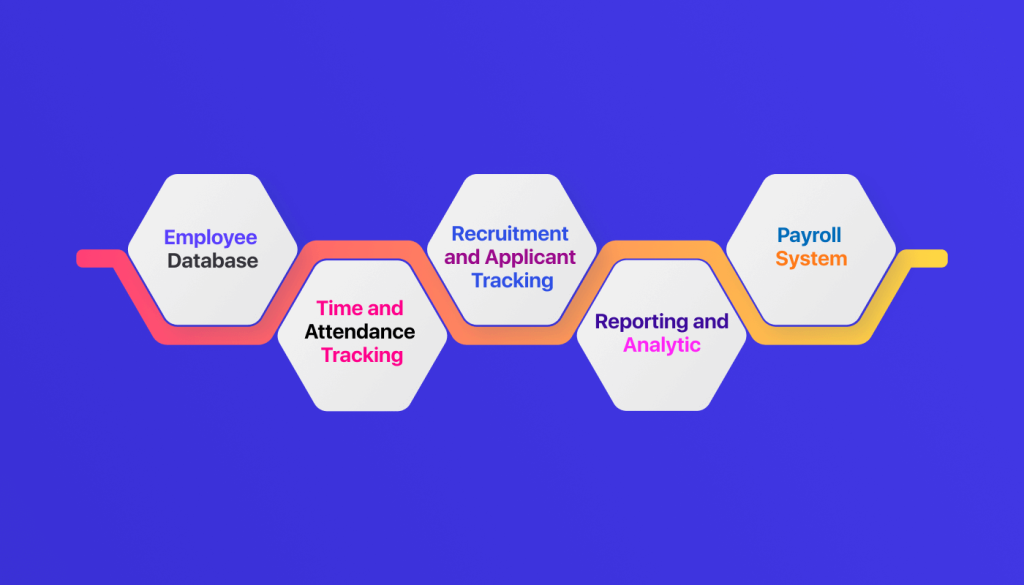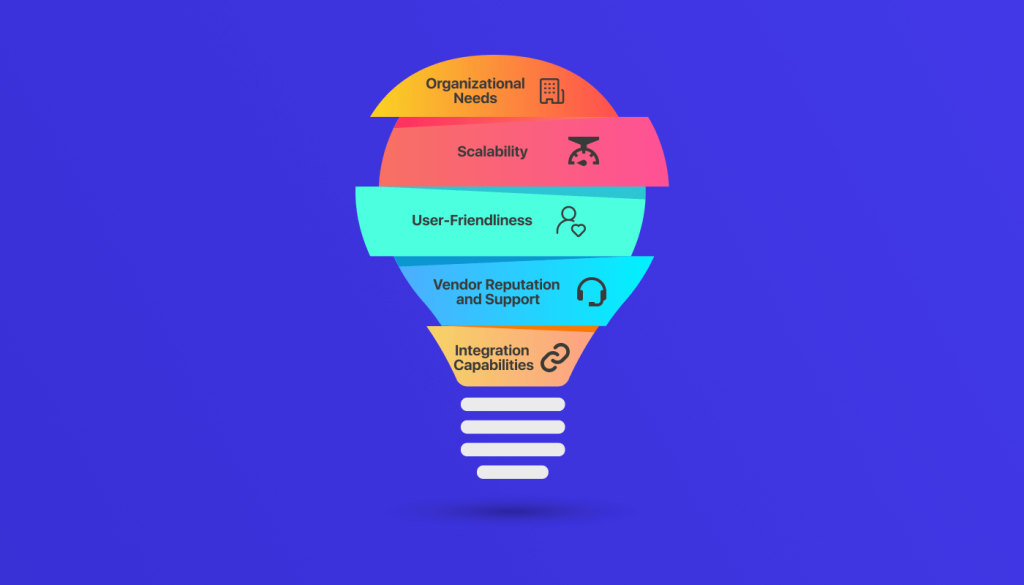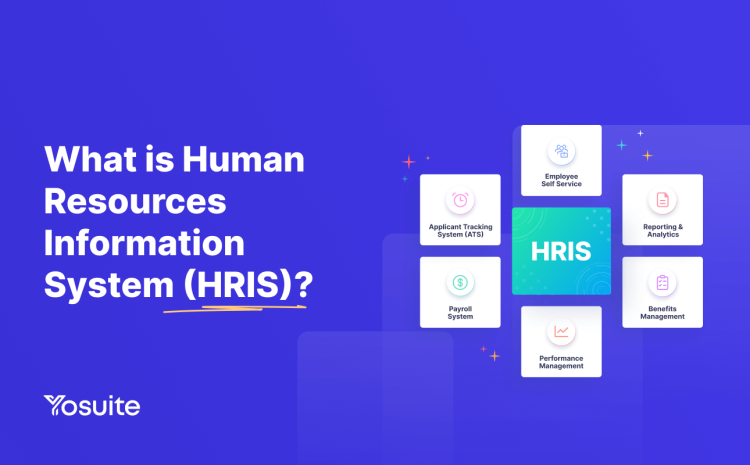Are manual processes and disconnected data hampering your HR performance? Then, HRIS is the transformative solution to automate HR tasks and boost efficiency.
Continue reading to learn about what is HRIS, its functionalities, and the working strategy for human resource management.
What is HRIS: Quick Overview
HRIS stands for Human Resource Information System. It’s a kind of HR software to integrate various human resource functions and processes into one centralized system.
It typically includes features such as employee information management, payroll, attendance tracking, benefits administration, training and development, reporting, and analytics.
With HRIS, your organization can reduce administrative burdens, and enhance data accuracy. Also, can empower strategic decision-making through access to real-time insights.
Types of HRIS
In general, human resource information system or HRIS is classified into 5 categories such as:
1. Operational HRIS: Handles daily HR tasks and processes including payroll and attendance.
2. Strategic HRIS: Integrates HR functions with organizational goals for data-driven decision-making.
3. Tactical HRIS: Addresses specific HR needs or projects, such as recruitment or training.
4. Comprehensive HRIS: Combines a broad range of HR functions for end-to-end management.
5. Limited-function: Also, known as specialized HRIS; targets specific HR areas, like benefits or time tracking, with specialized solutions.
Core Features of HRIS

HRIS comes with some effective features to bring a more agile and responsive workforce. Let’s explore the 5 core features of human resource information system software to manage the most valuable asset of businesses – people!
| Core Feature | Functionality |
|---|---|
| Employee Database Management | Centralizing storage for comprehensive employee information |
| Payroll System | Automating the processing of employee compensation and taxes |
| Time and Attendance Tracking | Monitoring work hours, absences, and attendance patterns |
| Reporting and Analytics | Generating insightful reports for decision-making and metrics |
| Recruitment and Applicant Tracking | Managing the entire hiring process through streamlined tracking |
How Does HRIS System Work
HRIS systems are designed to enhance efficiency, accuracy, and strategic decision-making in human resources. Here’s a quick overview of how this HR software works in an organization:
1️⃣ Centralizing Data Management
- Acts as a centralized database for comprehensive employee information
- Manages and stores data in a unified and accessible location
2️⃣ Enabling Employee Self-Service
- Facilitates employee autonomy through self-service portals.
- Allows employees to update personal details, request time off, and engage in HR processes independently.
3️⃣ Optimizing Recruitment and Applicant Tracking
- Manages the entire recruitment system efficiently.
- Organizes job applications, tracks candidates, and facilitates communication.
4️⃣ Automating Payroll Processing
- Automates accurate and timely payroll calculations.
- Ensures proper handling of employee compensation, tax deductions, and financial transactions.
5️⃣ Tracking Time and Attendance
- Monitors and records employee work hours, absences, and attendance patterns.
- Implements payroll processing, productivity evaluation, and compliance efforts.
6️⃣ Facilitating Performance Management
- Assists in goal setting, performance tracking, and feedback processes.
- Contributes to employee development and growth.
7️⃣ Generating Reports and Analytics
- Produces insightful reports and analytics on HR metrics.
- Empowers data-driven decisions and provides workforce trends effectively.
How HRIS Helps an Organization
HRIS, or Human Resource Information System, varies in functionalities based on the organization type and the specific tasks it needs to address.
HRIS systems are most commonly used in the large manufacturing industry (15.5%), services sector (13%), non-profit organizations (12%), and healthcare (10%).
Here’s a quick overview of how HRIS systems help different kinds of organizations:
✨ Large Enterprises
- Centralizing the storage of comprehensive employee data
- Offering a smooth hiring process with resume management and applicant tracking features
- Automating tracking of work hours, attendance, and leave requests for accurate payroll processing
- Managing employee benefits, such as health insurance and retirement plans
- Ensuring accurate and timely payments with the automation of payroll calculations
✨ Small and Medium Enterprises (SMEs)
- Automating repetitive HR tasks to enhance efficiency
- Offering functionalities for smaller organizations without unnecessary complexity
- Empowering employees to manage their information and requests
✨ Startups
- Managing the hiring process and onboarding new employees
- Offering flexibility and affordable price range to grow the organization
- Provides essential reporting features for informed insights
- Simplifying portals for employees to access and update their information
✨ Non-Profit Organizations
- Ensuring adherence to legal and regulatory requirements in the non-profit sector
- Tracking volunteer hours, skills, and contributions
- Managing relationships with donors and tracking grant-related information
✨ Educational Institutions
- Managing student and faculty data in addition to HR functions
- Facilitating professional development for faculty and staff
- Ensuring compliance with educational certifications
✨ Healthcare Organizations
- Addressing specific regulations in the healthcare sector
- Managing healthcare professionals’ qualifications and certifications
- Optimizing staff schedules to ensure adequate coverage
- Storing prescriptions securely and generating patient data reports
Good to know 👉 How Much Does HR Software Cost: Decoding the Price Tag
How to Implement HRIS
Implementing an HRIS (Human Resource Information System) in any company requires careful planning, collaboration, and attention to detail.
Here’s a complete guide on how you can implement HRIS in your company effectively. Also provide an example of implementing HRIS in a software company.
Establish a Cross-Functional Implementation Team
- Form a diverse team with representatives from HR, IT, and various departments.
- Ensure a comprehensive understanding of organizational needs and processes.
💡 For example, “XYZ Tech Solutions” is a software company, that can establish a cross-functional team comprising HR specialists, IT experts, and software development managers.
Thoroughly Assess HR and Organizational Workflows
- Conduct a detailed analysis of current HR processes and organizational workflows.
- Identify the pain points and specific requirements that the HRIS should address.
💡 To do so, “XYZ Tech Solutions” can conduct a thorough assessment, recognizing challenges in skill tracking, project management, and employee engagement within software development.
Select a Suitable HRIS Solution
- Choose an HRIS vendor with a proven track record and a solution.
- Make sure it’s aligned with the organization’s size, industry, and specific requirements.
💡 They can select an HRIS vendor to integrate the HRIS for the software development domain such as WordPress, AI, SaaS, or Android app development.
Comprehensive Employee Training
- Conduct thorough training sessions for HR personnel and employees.
- Ensure users understand how to use the HRIS for tasks such as employee onboarding, performance tracking, and benefits management.
💡 For this step, they can organize targeted training sessions, ensuring both HR professionals and software developers are proficient in using the HRIS for software-centric functions.
Phased Pilot Testing and Rollout
- Implement the HRIS in phases, starting with a pilot group.
- Gather feedback, address issues, and refine the system before expanding the implementation to the entire organization.
💡 As a software company, they can initiate a pilot implementation with a small software development team. It will ensure the identification and resolution of any issues specific to software workflows before a full rollout.
Continuous Monitoring and Optimization
- Establish a feedback loop, and regularly monitor HRIS performance.
- Make continuous optimizations to align with evolving organizational needs.
💡 Finally, they can set up a feedback mechanism and conduct regular reviews to ensure the HRIS remains effective and aligned with dynamic software development requirements.
Benefits and Limitations of HRIS
| Pros | Cons |
|---|---|
| ✅ Streamline HR Processes ✅ Enhance Data Accuracy ✅ Improve Data Accessibility ✅ Enhance Reporting Capabilities ✅ Efficient Time and Attendance Management | ❌ Initial learning curve ❌Implementation costs for small companies |
How to Choose the Right HRIS for Your Organization
Did you know that on average, companies take approximately 15 weeks to choose an HRIS, as reported by Software Path in 2022?
Selecting the right HRIS is crucial to ensure optimal functionality. So, when choosing a human resource information system software or HRIS for your organization, you need to consider the following factors:

1. Understand Organizational Needs
- Assessment: Conduct a comprehensive analysis of your organization’s HR requirements and challenges.
- Customization: Identify specific functionalities and features that align with your organizational goals.
2. Scalability
- Flexibility: Ensure the system can adapt to changing workforce needs and increased data volume.
- Future Growth: Choose an HRIS that can scale with your organization’s growth.
3. User-Friendliness
- Adoption: Prioritize a user-friendly interface to encourage widespread adoption.
- Training: Select a system with intuitive features to minimize the learning curve for both HR professionals and end-users.
4. Vendor Reputation and Support
- Research: Investigate vendor reputation through reviews, testimonials, and case studies.
- Support: Assess the quality and responsiveness of the vendor’s customer support, including available channels and response times.
5. Integration Capabilities
- Seamless Flow: Choose a system that allows seamless integration to avoid data silos and ensure efficient information flow.
- Compatibility: Verify the HRIS’s compatibility with existing software and systems within your organization.
Future Trends in HRIS
Understanding future HRIS trends is necessary for strategic planning, competitive advantage, and adapting to industry changes.
Here are the 5 upcoming trends in HRIS (including but not limited to):
✨ Cloud-Based Solutions
Cloud-based HR solutions are also in an upcoming trend. It will continue to gain popularity to enhance accessibility for remote and global teams.
✨ Mobile Accessibility
HRIS platforms will increasingly focus on mobile accessibility to provide dedicated apps for employees and HR professionals.
✨ Integration of Learning Management Systems (LMS)
HRIS will integrate with Learning Management Systems to facilitate continuous learning and development opportunities for employees.
✨ Secure Record-Keeping
To implement more secure HRIS software, Blockchain technology will be used for secure and transparent record-keeping. It will ensure the integrity and confidentiality of sensitive HR data.
✨ Artificial Intelligence (AI) Integration
AI-driven analytics will enable HRIS to predict workforce trends. That will help organizations make data-driven decisions in areas like talent acquisition, AI chatbot, performance management, and employee engagement.

FAQs
What is a key advantage of human resource information systems?
A key advantage of Human Resource Information Systems (HRIS) is efficient HR process management to enhance organizational effectiveness.
What should an HRIS have?
An ideal HRIS should include features like employee data management, recruitment tools, benefits administration, payroll processing, performance management, and analytics capabilities.
What are some examples of HRIS systems?
Examples include popular HRIS systems like Workday, SAP SuccessFactors, Oracle HCM Cloud, BambooHR, and ADP Workforce Now.
What are the challenges of using an HRIS in a large organization?
Challenges in large organizations may include integration complexities, data security concerns, resistance to change, and the need for substantial training to ensure effective adoption across the organization.
👉 Learn more – 15 HR Challenges and Solutions for Progressive Workplace
Wrap it up
Hopefully, now you can understand what HRIS is, its features, work methodologies, key considerations, and possible future integrations.
The right HRIS helps HR professionals focus on strategic tasks rather than spending excessive time on administrative and repetitive processes.
Overall, HRIS is not just a piece of software; it’s a must-have element for organizational effectiveness.



Leave a Reply